PUB705 Health Promotion: Family Planning in Sub-Saharan Africa Report
VerifiedAdded on 2023/03/30
|7
|710
|85
Report
AI Summary
This report examines the critical issue of family planning in Sub-Saharan Africa, highlighting the lack of awareness and access to contraceptive methods. It identifies the community most affected, emphasizing the high fertility rates and the impact on population growth and poverty. The report analyzes individual determinants such as lack of knowledge and negative attitudes towards contraception, as well as environmental determinants like cultural norms and economic factors that influence family size. It underscores the need for government intervention and health promotion strategies to address these challenges and improve maternal health outcomes. The analysis utilizes relevant literature to support its findings and provide a comprehensive overview of the issue.

Family Planning – Sub-Saharan
Africa
Student’s Name
Institution and Department
Institution’s Location
Date of Submission
Africa
Student’s Name
Institution and Department
Institution’s Location
Date of Submission
Paraphrase This Document
Need a fresh take? Get an instant paraphrase of this document with our AI Paraphraser
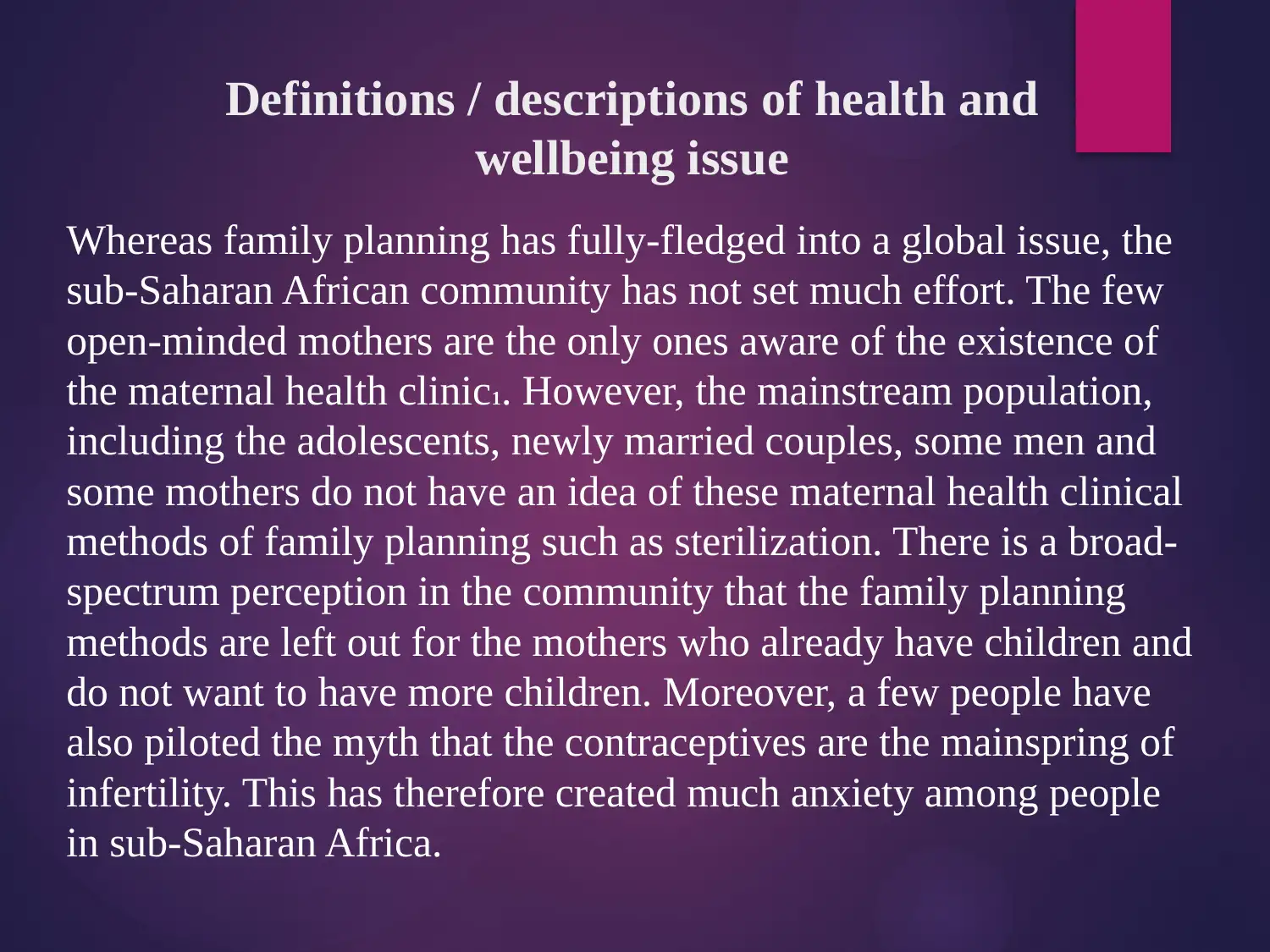
Definitions / descriptions of health and
wellbeing issue
Whereas family planning has fully-fledged into a global issue, the
sub-Saharan African community has not set much effort. The few
open-minded mothers are the only ones aware of the existence of
the maternal health clinic1. However, the mainstream population,
including the adolescents, newly married couples, some men and
some mothers do not have an idea of these maternal health clinical
methods of family planning such as sterilization. There is a broad-
spectrum perception in the community that the family planning
methods are left out for the mothers who already have children and
do not want to have more children. Moreover, a few people have
also piloted the myth that the contraceptives are the mainspring of
infertility. This has therefore created much anxiety among people
in sub-Saharan Africa.
wellbeing issue
Whereas family planning has fully-fledged into a global issue, the
sub-Saharan African community has not set much effort. The few
open-minded mothers are the only ones aware of the existence of
the maternal health clinic1. However, the mainstream population,
including the adolescents, newly married couples, some men and
some mothers do not have an idea of these maternal health clinical
methods of family planning such as sterilization. There is a broad-
spectrum perception in the community that the family planning
methods are left out for the mothers who already have children and
do not want to have more children. Moreover, a few people have
also piloted the myth that the contraceptives are the mainspring of
infertility. This has therefore created much anxiety among people
in sub-Saharan Africa.
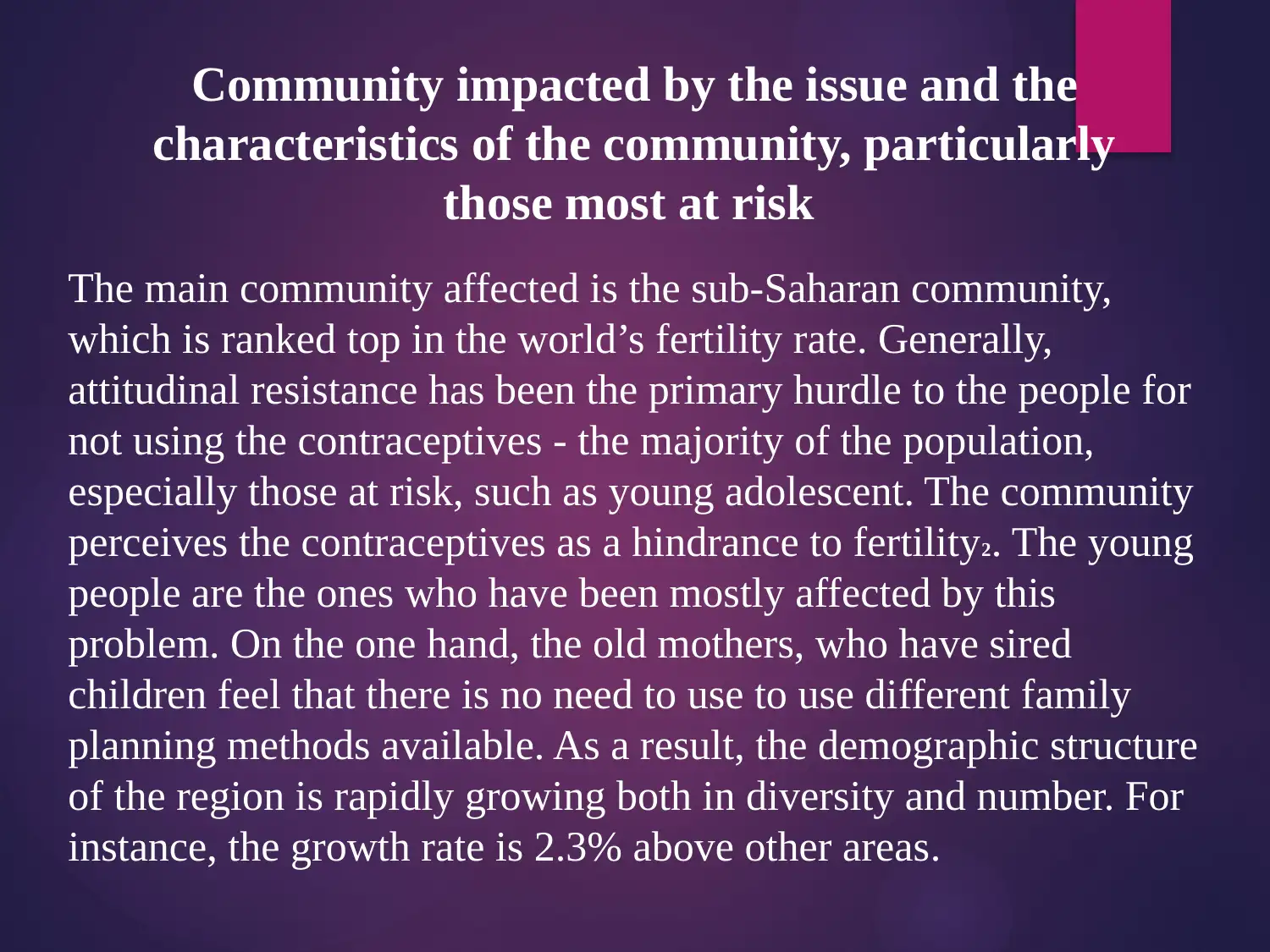
Community impacted by the issue and the
characteristics of the community, particularly
those most at risk
The main community affected is the sub-Saharan community,
which is ranked top in the world’s fertility rate. Generally,
attitudinal resistance has been the primary hurdle to the people for
not using the contraceptives - the majority of the population,
especially those at risk, such as young adolescent. The community
perceives the contraceptives as a hindrance to fertility2. The young
people are the ones who have been mostly affected by this
problem. On the one hand, the old mothers, who have sired
children feel that there is no need to use to use different family
planning methods available. As a result, the demographic structure
of the region is rapidly growing both in diversity and number. For
instance, the growth rate is 2.3% above other areas.
characteristics of the community, particularly
those most at risk
The main community affected is the sub-Saharan community,
which is ranked top in the world’s fertility rate. Generally,
attitudinal resistance has been the primary hurdle to the people for
not using the contraceptives - the majority of the population,
especially those at risk, such as young adolescent. The community
perceives the contraceptives as a hindrance to fertility2. The young
people are the ones who have been mostly affected by this
problem. On the one hand, the old mothers, who have sired
children feel that there is no need to use to use different family
planning methods available. As a result, the demographic structure
of the region is rapidly growing both in diversity and number. For
instance, the growth rate is 2.3% above other areas.
⊘ This is a preview!⊘
Do you want full access?
Subscribe today to unlock all pages.

Trusted by 1+ million students worldwide
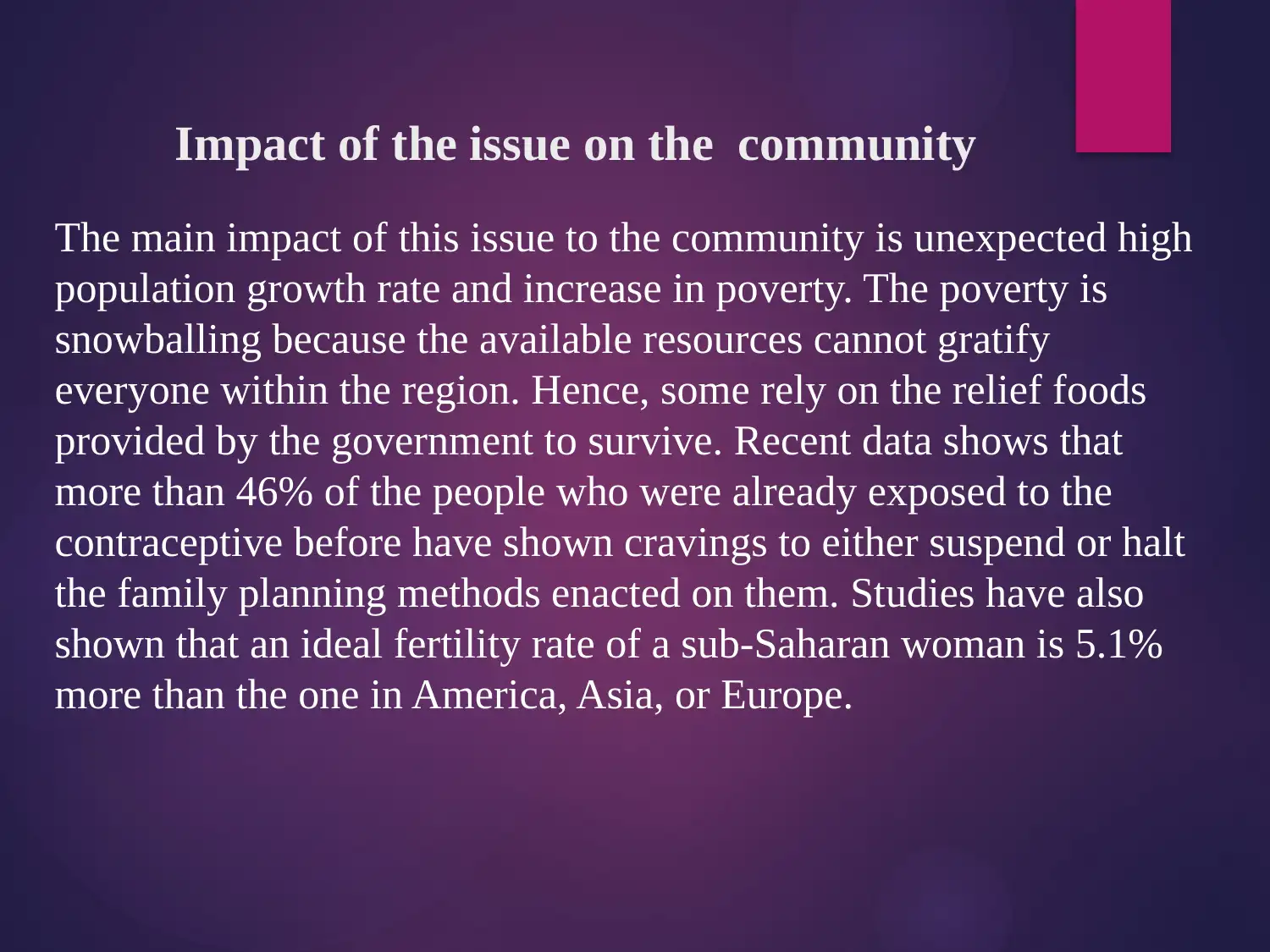
Impact of the issue on the community
The main impact of this issue to the community is unexpected high
population growth rate and increase in poverty. The poverty is
snowballing because the available resources cannot gratify
everyone within the region. Hence, some rely on the relief foods
provided by the government to survive. Recent data shows that
more than 46% of the people who were already exposed to the
contraceptive before have shown cravings to either suspend or halt
the family planning methods enacted on them. Studies have also
shown that an ideal fertility rate of a sub-Saharan woman is 5.1%
more than the one in America, Asia, or Europe.
The main impact of this issue to the community is unexpected high
population growth rate and increase in poverty. The poverty is
snowballing because the available resources cannot gratify
everyone within the region. Hence, some rely on the relief foods
provided by the government to survive. Recent data shows that
more than 46% of the people who were already exposed to the
contraceptive before have shown cravings to either suspend or halt
the family planning methods enacted on them. Studies have also
shown that an ideal fertility rate of a sub-Saharan woman is 5.1%
more than the one in America, Asia, or Europe.
Paraphrase This Document
Need a fresh take? Get an instant paraphrase of this document with our AI Paraphraser
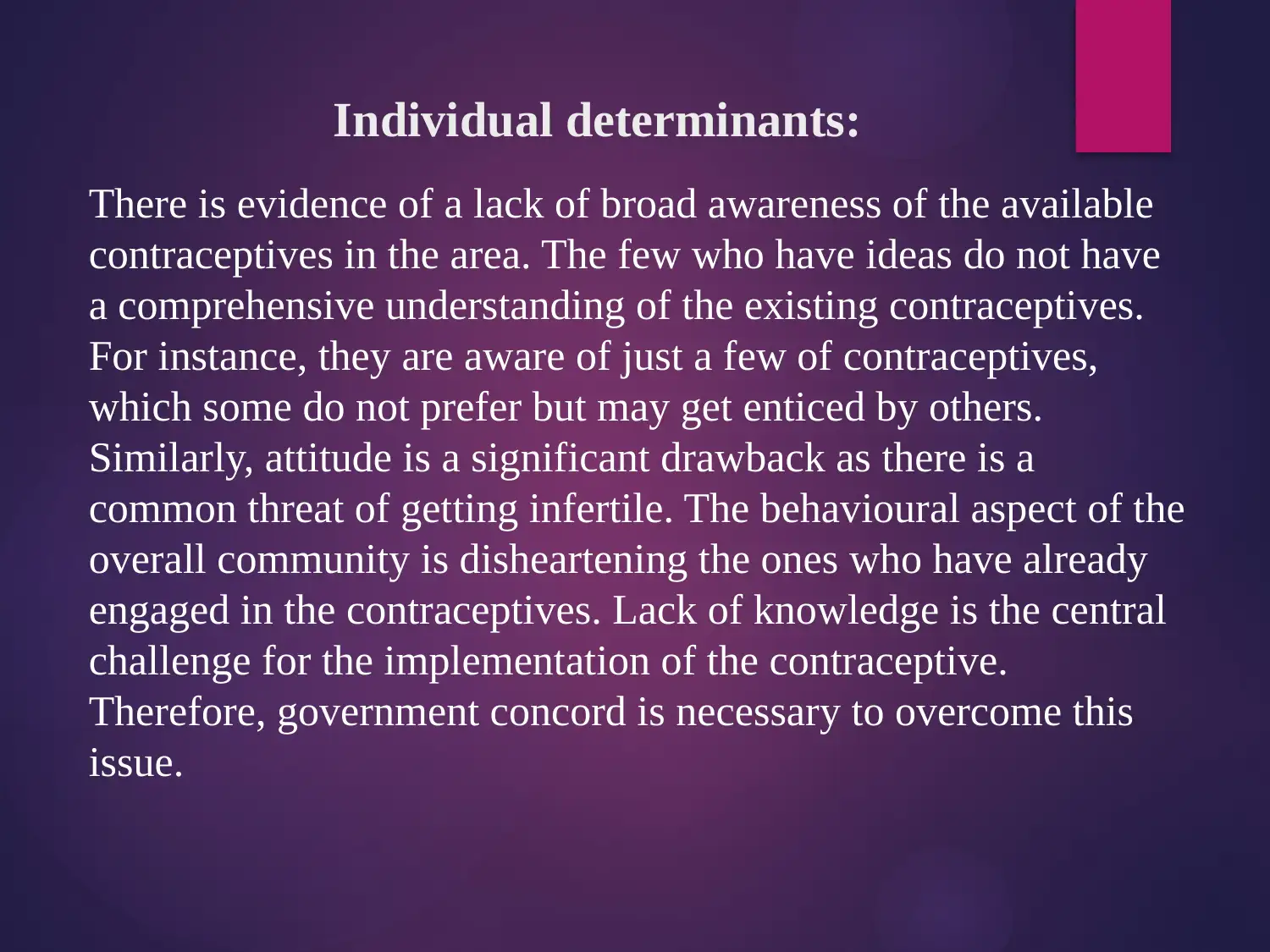
Individual determinants:
There is evidence of a lack of broad awareness of the available
contraceptives in the area. The few who have ideas do not have
a comprehensive understanding of the existing contraceptives.
For instance, they are aware of just a few of contraceptives,
which some do not prefer but may get enticed by others.
Similarly, attitude is a significant drawback as there is a
common threat of getting infertile. The behavioural aspect of the
overall community is disheartening the ones who have already
engaged in the contraceptives. Lack of knowledge is the central
challenge for the implementation of the contraceptive.
Therefore, government concord is necessary to overcome this
issue.
There is evidence of a lack of broad awareness of the available
contraceptives in the area. The few who have ideas do not have
a comprehensive understanding of the existing contraceptives.
For instance, they are aware of just a few of contraceptives,
which some do not prefer but may get enticed by others.
Similarly, attitude is a significant drawback as there is a
common threat of getting infertile. The behavioural aspect of the
overall community is disheartening the ones who have already
engaged in the contraceptives. Lack of knowledge is the central
challenge for the implementation of the contraceptive.
Therefore, government concord is necessary to overcome this
issue.
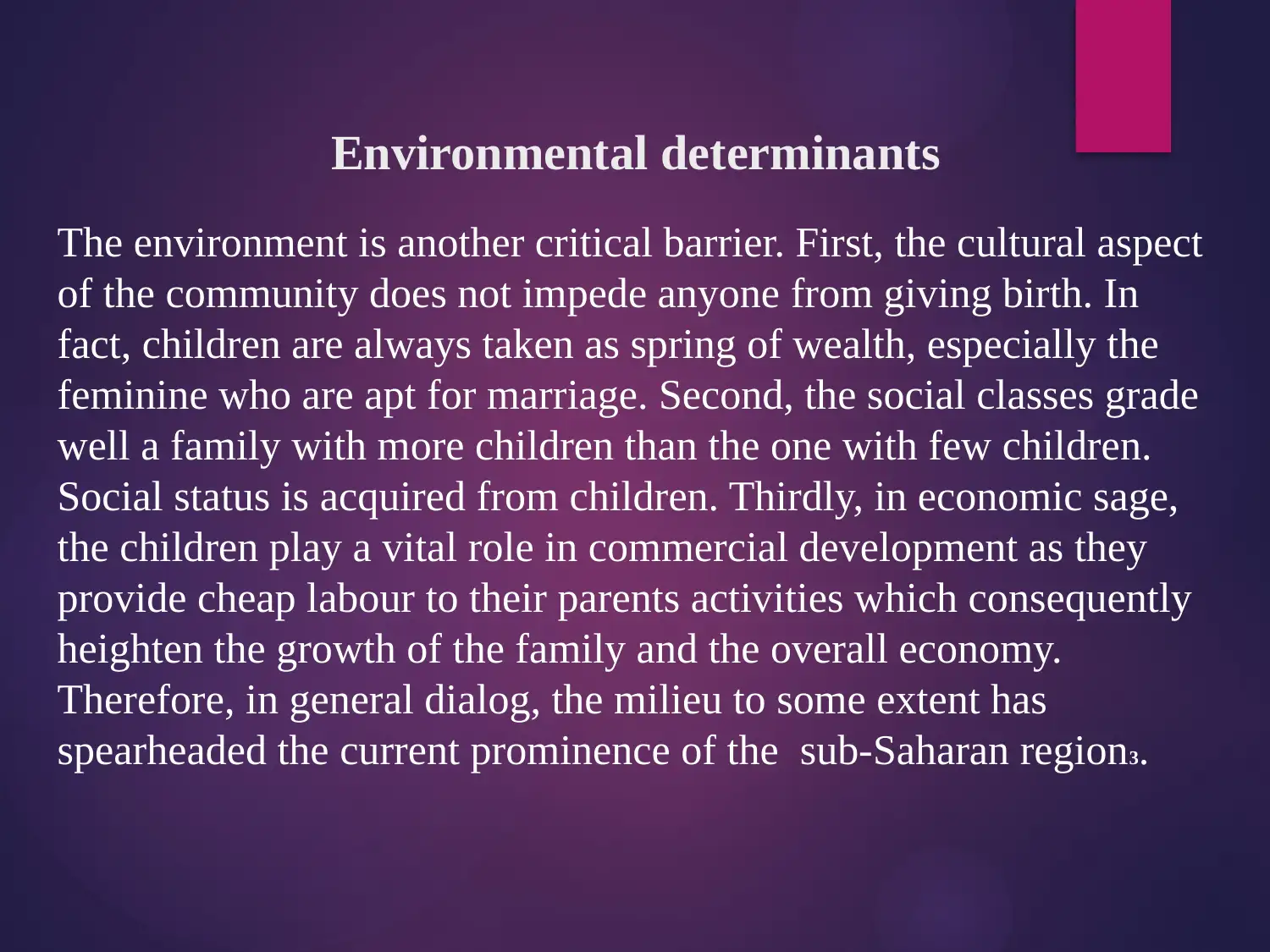
Environmental determinants
The environment is another critical barrier. First, the cultural aspect
of the community does not impede anyone from giving birth. In
fact, children are always taken as spring of wealth, especially the
feminine who are apt for marriage. Second, the social classes grade
well a family with more children than the one with few children.
Social status is acquired from children. Thirdly, in economic sage,
the children play a vital role in commercial development as they
provide cheap labour to their parents activities which consequently
heighten the growth of the family and the overall economy.
Therefore, in general dialog, the milieu to some extent has
spearheaded the current prominence of the sub-Saharan region3.
The environment is another critical barrier. First, the cultural aspect
of the community does not impede anyone from giving birth. In
fact, children are always taken as spring of wealth, especially the
feminine who are apt for marriage. Second, the social classes grade
well a family with more children than the one with few children.
Social status is acquired from children. Thirdly, in economic sage,
the children play a vital role in commercial development as they
provide cheap labour to their parents activities which consequently
heighten the growth of the family and the overall economy.
Therefore, in general dialog, the milieu to some extent has
spearheaded the current prominence of the sub-Saharan region3.
⊘ This is a preview!⊘
Do you want full access?
Subscribe today to unlock all pages.

Trusted by 1+ million students worldwide
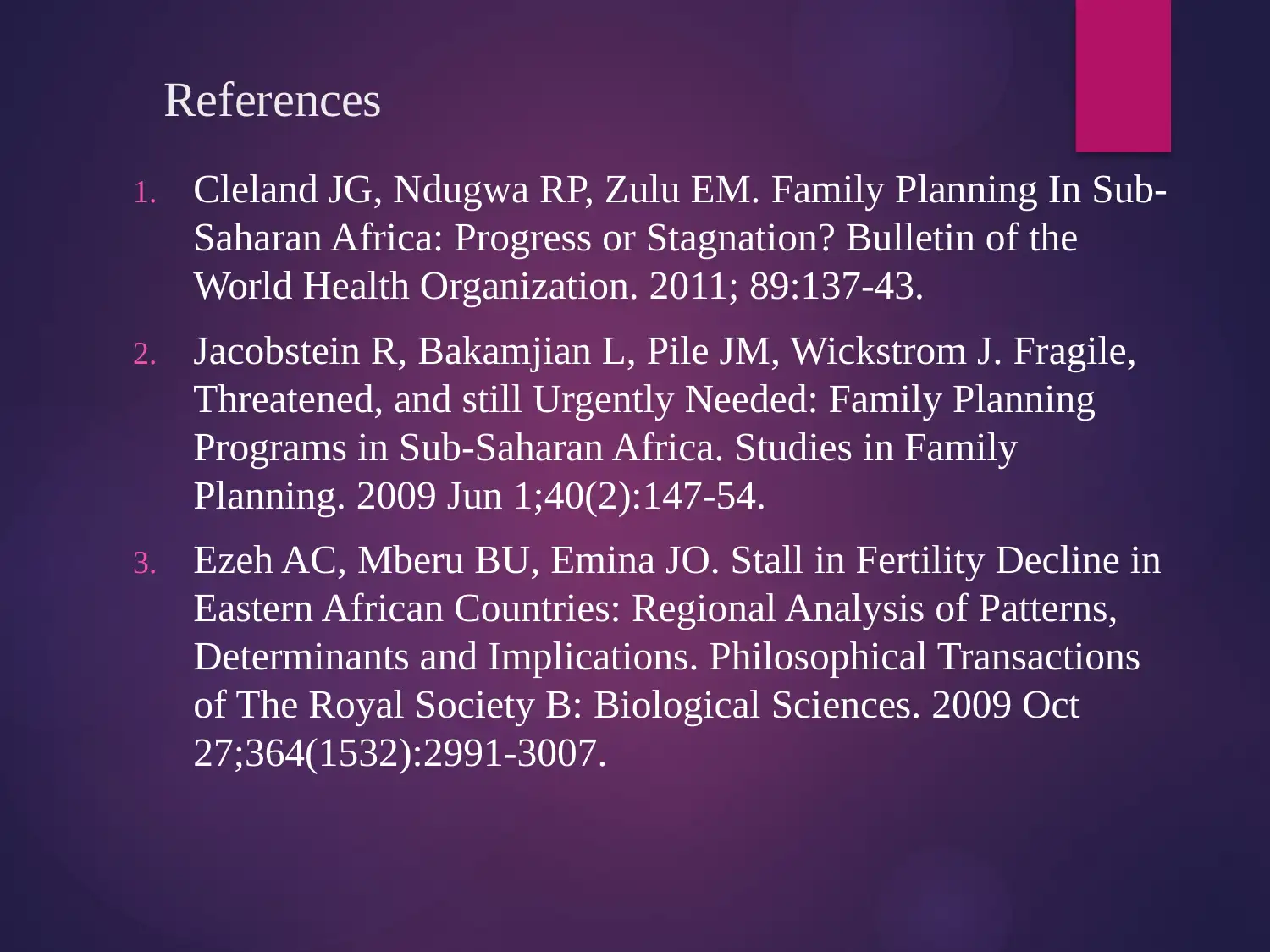
References
1. Cleland JG, Ndugwa RP, Zulu EM. Family Planning In Sub-
Saharan Africa: Progress or Stagnation? Bulletin of the
World Health Organization. 2011; 89:137-43.
2. Jacobstein R, Bakamjian L, Pile JM, Wickstrom J. Fragile,
Threatened, and still Urgently Needed: Family Planning
Programs in Sub-Saharan Africa. Studies in Family
Planning. 2009 Jun 1;40(2):147-54.
3. Ezeh AC, Mberu BU, Emina JO. Stall in Fertility Decline in
Eastern African Countries: Regional Analysis of Patterns,
Determinants and Implications. Philosophical Transactions
of The Royal Society B: Biological Sciences. 2009 Oct
27;364(1532):2991-3007.
1. Cleland JG, Ndugwa RP, Zulu EM. Family Planning In Sub-
Saharan Africa: Progress or Stagnation? Bulletin of the
World Health Organization. 2011; 89:137-43.
2. Jacobstein R, Bakamjian L, Pile JM, Wickstrom J. Fragile,
Threatened, and still Urgently Needed: Family Planning
Programs in Sub-Saharan Africa. Studies in Family
Planning. 2009 Jun 1;40(2):147-54.
3. Ezeh AC, Mberu BU, Emina JO. Stall in Fertility Decline in
Eastern African Countries: Regional Analysis of Patterns,
Determinants and Implications. Philosophical Transactions
of The Royal Society B: Biological Sciences. 2009 Oct
27;364(1532):2991-3007.
1 out of 7
Related Documents
Your All-in-One AI-Powered Toolkit for Academic Success.
+13062052269
info@desklib.com
Available 24*7 on WhatsApp / Email
![[object Object]](/_next/static/media/star-bottom.7253800d.svg)
Unlock your academic potential
Copyright © 2020–2025 A2Z Services. All Rights Reserved. Developed and managed by ZUCOL.





